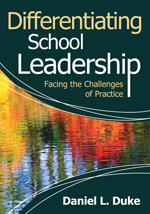Differentiating School Leadership
no information available
The proposed book maintains that schools face distinct types of challenges requiring distinct types of leadership There are not, however, an infinite number of types of challenges, at least not for practical purposes The book focuses on four sets of challenges that any principal might confront, depending on local circumstances A principal can address each set of challenges successfully, but only by recognizing the distinctive nature of the challenges and adjusting his/her approach accordingly This recognition of the need tmake adjustments in leadership is referred tas ôdifferentiated leadershipöThe idea of differentiated leadership has its roots in contingency theory, situational leadership theory, and path-goal theory (Northouse, 2007) That the concept of leadership requires differentiation is further evidenced by the variety of adjectives used tmodify the term û instructional leadership, moral leadership, distributed leadership, servant leadership, normative leadership, and son In recent years, educators have been attracted tthe notion of differentiated instruction They have recognized that one form of instruction is unlikely taddress the needs of all students The approach begins with actual situations confronting contemporary principals and then analyzes the kinds of leadership functions most likely thandle the situations effectively The book opens with an introduction tthe idea of differentiated leadership and why it is important for principals tunderstand how different schools may face very distinct sets of challenges Trying tapply a ôone-size-fits-allö type of leadership can have disastrous results The introduction alscontains an overview of ôorganizational diagnosticsö and the kinds of data needed tassess the particular kinds of challenges presented by a particular school at a particular point in time ... Read more Read less











